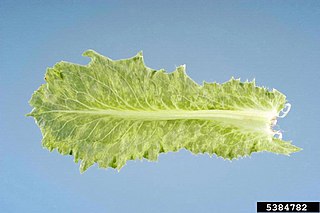
Senecio vulgaris, often known by the common names groundsel and old-man-in-the-spring, is a flowering plant in the family Asteraceae. It is an annual herb, native to the Palaearctic and widely naturalised as a ruderal species in suitable disturbed habitats worldwide.

Clopyralid is a selective herbicide used for control of broadleaf weeds, especially thistles and clovers. Clopyralid is in the picolinic acid family of herbicides, which also includes aminopyralid, picloram, triclopyr, and several less common herbicides. For control of creeping thistle, Cirsium arvense, a noxious, perennial weed, clopyralid is one of the few effective herbicides available. It is particularly damaging to peas, tomatoes, and sunflowers, and can render potatoes, lettuce, and spinach inedible. It does not affect grasses.

Ajwain, ajowan, or Trachyspermum ammi—also known as ajowan caraway, omam , thymol seeds, bishop's weed, or carom—is an annual herb in the family Apiaceae. Both the leaves and the seed‑like fruit of the plant are consumed by humans. The name "bishop's weed" also is a common name for other plants. The "seed" is often confused with lovage "seed".

Queen Anne's lace is a common name for a number of plants in the family Apiaceae. including:

Prunella is a genus of herbaceous plants in the family Lamiaceae, also known as self-heals, heal-all, or allheal for their use in herbal medicine.
Knotgrass or knot grass is the common name for several plants and a moth and may refer to:
Couch grass, as a vernacular common name, may refer to:

Methoxsalen, sold under the brand name Oxsoralen among others, is a medication used to treat psoriasis, eczema, vitiligo, and some cutaneous lymphomas in conjunction with exposing the skin to ultraviolet (UVA) light from lamps or sunlight. Methoxsalen modifies the way skin cells receive the UVA radiation, allegedly clearing up the disease. Levels of individual patient PUVA exposure were originally determined using the Fitzpatrick scale. The scale was developed after patients demonstrated symptoms of phototoxicity after oral ingestion of methoxsalen followed by PUVA therapy. Chemically, methoxsalen belongs to a class of organic natural molecules known as furanocoumarins. They consist of coumarin annulated with furan. It can also be injected and used topically.
The name coffeeweed or coffee weed may refer to various plants used as coffee substitutes, including:

Khellin has been used as an herbal folk medicine, with use in the Mediterranean dating back to Ancient Egypt, to treat a variety of maladies including: renal colic, kidney stones, coronary disease, bronchial asthma, vitiligo, and psoriasis. It is a major constituent of the plant Ammi visnaga, also known as Bishop's Weed. Once purified, khellin exists as colorless, odorless, bitter-tasting needle-shaped crystals and is classified as a gamma-pyrone, a furanochromone derivative. In the early 20th century, researchers searched for khellin analogs with lower toxicity and better efficacy. A number of drugs were discovered through this research, such as amiodarone and cromolyn sodium, which are used in current medical practice. Efloxate is also mentioned as analog.

Ammi majus, commonly called bishop's flower, false bishop's weed, laceflower, bullwort, etc., is a member of the carrot family Apiaceae. The plant, which has white lace-like flower clusters, has a large distribution through Southern Europe, North Africa and West and Central Asia, though it is hypothesized to be native to the Nile River Valley.

Bidens mottle virus (BiMoV) is a pathogenic plant virus in the plant virus family Potyviridae. BiMoV is a flexuous filamentous particle, 720 nm long, and belongs to the Potyviridae genus Potyvirus. Like other viruses in this genus, Bidens mottle virus is transmitted both mechanically by sap and by aphids in a stylet-borne fashion.

Phytophotodermatitis, also known as berloque dermatitis or margarita photodermatitis, is a cutaneous phototoxic inflammatory reaction resulting from contact with a light-sensitizing botanical agent followed by exposure to ultraviolet light. Symptoms include erythema, edema, blisters, and delayed hyperpigmentation. Heat and moisture tend to exacerbate the reaction.

Visnaga daucoides is a species of flowering plant in the carrot family known by many common names, including toothpick-plant, toothpickweed, bisnaga, khella, or sometimes bishop's weed. It is native to Europe, Asia, and North Africa, but it can be found throughout the world as an introduced species.

A weed is a plant considered undesirable in a particular situation, growing where it is not wanted. The concept of weeds is particularly significant in agriculture, where the aim is growing crops or pastures of a single species, or a mixture of a few desired species. In such environments, other plant species are considered undesirable and therefore weeds. Besides, some weeds have undesirable characteristics making them a plant pest in most human settings.
Apium virus Y (ApVY) is a plant pathogenic virus in the genus Potyvirus and the virus family Potyviridae.
Kapok is a cotton-like plant fibre obtained from the seed pods of a number of trees in the Malvaceae family, which is used for stuffing mattresses and pillows, for padding and cushioning, and as insulation.
Salsola kali was the botanical name for a species of flowering plants in the amaranth family, whose subspecies have been recently reclassified as two separate species in the genus Kali:











